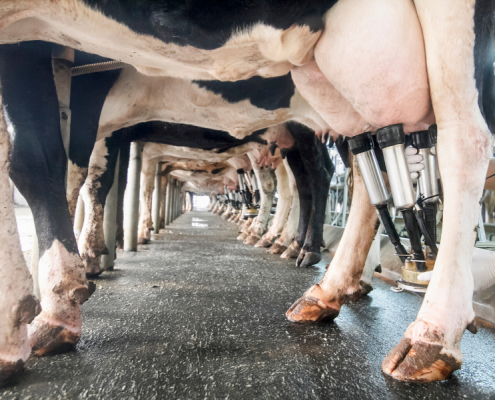How to increase butterfat in dairy cows?
The increase of butterfat in dairy cows remains a trending topic among farmers. Milk butterfat, milk yield and milk composition can vary per dairy cattle. This depends on the age, breed and stage of lactation of the cow. As cow milk yields have increased over the decades there has being a decline in milk butterfat. This is generally associated with production levels, management and feeding practices. It is a constant trend whether cows are kept indoors or managed in grazing only systems and it can have far reaching economic consequences and cattle herd health implications.
Several factors are involved in milk butterfat depression. The main contributing factors are heat stress and dietary formulation. In many parts of the world heat stress is associated with dairy production losses and herd health issues with very measurable reductions in cow dry matter intakes and overall rumination levels which lead to increased acid loads in the rumen associated with rumen acidosis.
Milk butterfat concentrations are reduced by:
- heat stress
- feeding diets with high starch levels and unsaturated fat
- low rumen pH may lead to flux of fatty acids
- changes in rumen biohydrogenation of unsaturated fatty acids
- reduction of milk fat synthesis in the mammary gland
Dairy cow milk butterfat mechanisms
There are generally two potential mechanisms for milk fat depression. The negative effect of incomplete bio-hydrogenation pathways was described by Harvatine et al. (2007). In this instance milk fat depression was associated with either
- the presence of high levels Polyunsaturated fatty acids (PUFAs) in the rumen through their addition in the diet (they are often present in large volumes in high quality pasture) or
- alteration in rumen fermentation pathways linked to high concentrate low fibre diets
Fatty acids are usually bio-hydrogenated in the rumen, but when rumen pH is low, a large amount of the fatty acids are only partially bio-hydrogenated. This change in fatty acid metabolism results in the production of milk fat depressing intermediates.
In grazing cows, a low rumen pH again contributes to this problem. O’Grady et al. (2008) showed that low rumen pH is prevalent in grazing Irish dairy cattle consuming perennial rye grass-based pasture.
Dietary ingredients and forage to concentrate ratios are also important factors in milk fat depression for dairy cows. High starch levels can result in poor rumen fermentation and reduced volatile fatty acid production (VFA). Butyrate alone is responsible for 50% of the fat destined for the udder. This means that a reduction in VFA due to impaired rumen function can depress milk fat production. The inclusion of dietary buffers has long been used as a strategy to optimise rumen function and enhance milk fat production.
CalMin ProMin Acid Buf optimises rumen function
A study by Cruywagen et al. (2015) clearly demonstrated a milk yield and milk fat response. Objective was to compare 180 gram per cow and day sodium bicarbonate and 90 gram
Six rumen cannulated cows were used in the trial. The experiment was a balanced cross-over design in which the cows were fed each treatment for a total of 22 days. Each 22 day period consisted of an adaptation period of 15 days and a data collection period of 7 days.
Dairy cattle were fed twice daily. The difference between the dairy cow diets was only the inclusion of either sodium bicarbonate,
The pH curves produced from the cows are shown in the video. Comparison of the rumen pH suggested that the cows were very acidotic when on the control diet, but the addition of a rumen buffer provided relief.
Inclusion of either buffer increased rumen pH after the first feed. The lowest rumen pH was reached in the late evening. The rumen pH results for
When comparing rumen pH across the treatments, control diet showed a rumen pH remaining below 5.5 for 14 hours in the day. Sodium bicarbonate reduced this to 7.5 hours and only 3.5 hours for the
Video: results rumen pH and acidosis (Cruywagen et al. 2015)
CalMin ProMin Acid Buf drives milk butterfat and improves feed efficiency
Results dairy cow performance (Cruywagen et al. 2015)

Milk yield per cow and day was increased by the addition of a rumen buffer. The control treatment yielded 27.6 L milk per day. Sodium bicarbonate lifted performance up to 29.1 L milk. With
Milk fat percentage was significantly increased over control for both rumen buffers. Total milk solids kilograms per cow per day were also significantly increased by the addition of
Conclusions
The control diet used in this dairy trial resulted in rumen acidosis. This was relieved by the addition of rumen buffers.
This research project is published in the Journal of Dairy Science. Download the full article here and get powered by our science.
- increase milk yield and milk butterfat
- long term optimum pH in the rumen
- healthy rumen function, reduce subclinical rumen acidosis (SARA)
- increase productivity per kilo dry matter intake

Related articles
 https://celticseaminerals.com/wp-content/uploads/2021/02/Transition-cow-Acid-Buf-CSM-800x600-1.png
600
800
Patricia
https://celticseaminerals.com/wp-content/uploads/2020/01/Celtic_13.png
Patricia2021-02-08 15:05:032023-03-02 13:35:35Transition Cow Management
https://celticseaminerals.com/wp-content/uploads/2021/02/Transition-cow-Acid-Buf-CSM-800x600-1.png
600
800
Patricia
https://celticseaminerals.com/wp-content/uploads/2020/01/Celtic_13.png
Patricia2021-02-08 15:05:032023-03-02 13:35:35Transition Cow Management https://celticseaminerals.com/wp-content/uploads/2020/11/CSM-CeltiMin-layers-featured-image-webpage-800x600-1.png
600
800
Patricia
https://celticseaminerals.com/wp-content/uploads/2020/01/Celtic_13.png
Patricia2020-11-03 15:41:302023-03-02 13:36:21How to prevent eggshell quality problems?
https://celticseaminerals.com/wp-content/uploads/2020/11/CSM-CeltiMin-layers-featured-image-webpage-800x600-1.png
600
800
Patricia
https://celticseaminerals.com/wp-content/uploads/2020/01/Celtic_13.png
Patricia2020-11-03 15:41:302023-03-02 13:36:21How to prevent eggshell quality problems? https://celticseaminerals.com/wp-content/uploads/2020/09/CSM-featured-image-gastric-pH-800x600px.png
600
800
Patricia
https://celticseaminerals.com/wp-content/uploads/2020/01/Celtic_13.png
Patricia2020-09-20 15:10:092023-03-02 13:36:48How gastric pH affects pig gut health
https://celticseaminerals.com/wp-content/uploads/2020/09/CSM-featured-image-gastric-pH-800x600px.png
600
800
Patricia
https://celticseaminerals.com/wp-content/uploads/2020/01/Celtic_13.png
Patricia2020-09-20 15:10:092023-03-02 13:36:48How gastric pH affects pig gut health https://celticseaminerals.com/wp-content/uploads/2020/07/CSM-featured-image-heat-stress-asia.png
600
800
Patricia
https://celticseaminerals.com/wp-content/uploads/2020/01/Celtic_13.png
Patricia2020-07-28 08:45:572023-03-02 13:38:15Heat stress in dairy cows
https://celticseaminerals.com/wp-content/uploads/2020/07/CSM-featured-image-heat-stress-asia.png
600
800
Patricia
https://celticseaminerals.com/wp-content/uploads/2020/01/Celtic_13.png
Patricia2020-07-28 08:45:572023-03-02 13:38:15Heat stress in dairy cows https://celticseaminerals.com/wp-content/uploads/2020/06/CSM-featured-image-feed-efficiency-800x600px.png
600
800
Patricia
https://celticseaminerals.com/wp-content/uploads/2020/01/Celtic_13.png
Patricia2020-06-30 12:28:302023-03-02 13:39:19Improving feed efficiency in dairy cows
https://celticseaminerals.com/wp-content/uploads/2020/06/CSM-featured-image-feed-efficiency-800x600px.png
600
800
Patricia
https://celticseaminerals.com/wp-content/uploads/2020/01/Celtic_13.png
Patricia2020-06-30 12:28:302023-03-02 13:39:19Improving feed efficiency in dairy cows https://celticseaminerals.com/wp-content/uploads/2020/06/CSM-featured-image-piglets-sleeping-800x600px.png
600
800
Patricia
https://celticseaminerals.com/wp-content/uploads/2020/01/Celtic_13.png
Patricia2020-06-23 15:33:152023-03-02 13:40:54How to reduce pig aggression?
https://celticseaminerals.com/wp-content/uploads/2020/06/CSM-featured-image-piglets-sleeping-800x600px.png
600
800
Patricia
https://celticseaminerals.com/wp-content/uploads/2020/01/Celtic_13.png
Patricia2020-06-23 15:33:152023-03-02 13:40:54How to reduce pig aggression? https://celticseaminerals.com/wp-content/uploads/2020/06/CSM-featured-image-beef-cattle-charolais-800x600px.png
600
800
Patricia
https://celticseaminerals.com/wp-content/uploads/2020/01/Celtic_13.png
Patricia2020-06-16 07:25:322023-03-02 13:41:17Fiber digestion drives beef cattle performance
https://celticseaminerals.com/wp-content/uploads/2020/06/CSM-featured-image-beef-cattle-charolais-800x600px.png
600
800
Patricia
https://celticseaminerals.com/wp-content/uploads/2020/01/Celtic_13.png
Patricia2020-06-16 07:25:322023-03-02 13:41:17Fiber digestion drives beef cattle performance Celtic Sea Minerals
https://celticseaminerals.com/wp-content/uploads/2020/06/CSM-featured-image-dairy-cow-neville-800x600px.png
600
800
Patricia
https://celticseaminerals.com/wp-content/uploads/2020/01/Celtic_13.png
Patricia2020-06-01 20:53:282023-03-02 13:44:46How a rumen buffer drives dairy performance
Celtic Sea Minerals
https://celticseaminerals.com/wp-content/uploads/2020/06/CSM-featured-image-dairy-cow-neville-800x600px.png
600
800
Patricia
https://celticseaminerals.com/wp-content/uploads/2020/01/Celtic_13.png
Patricia2020-06-01 20:53:282023-03-02 13:44:46How a rumen buffer drives dairy performance https://celticseaminerals.com/wp-content/uploads/2020/05/CSM-featured-image-holstein-cow-gras-800x600px.png
600
800
Patricia
https://celticseaminerals.com/wp-content/uploads/2020/01/Celtic_13.png
Patricia2020-05-24 21:54:212023-03-02 13:45:11How to reduce the risk for grass staggers?
https://celticseaminerals.com/wp-content/uploads/2020/05/CSM-featured-image-holstein-cow-gras-800x600px.png
600
800
Patricia
https://celticseaminerals.com/wp-content/uploads/2020/01/Celtic_13.png
Patricia2020-05-24 21:54:212023-03-02 13:45:11How to reduce the risk for grass staggers? https://celticseaminerals.com/wp-content/uploads/2020/05/CSM-featured-image-pig-nose-800x600px.png
600
800
Patricia
https://celticseaminerals.com/wp-content/uploads/2020/01/Celtic_13.png
Patricia2020-05-12 22:21:192023-03-02 13:46:30How to prevent gastric ulcers in pigs?
https://celticseaminerals.com/wp-content/uploads/2020/05/CSM-featured-image-pig-nose-800x600px.png
600
800
Patricia
https://celticseaminerals.com/wp-content/uploads/2020/01/Celtic_13.png
Patricia2020-05-12 22:21:192023-03-02 13:46:30How to prevent gastric ulcers in pigs? Celtic Sea Minerals
https://celticseaminerals.com/wp-content/uploads/2020/04/CSM-Iceland-Marine-Minerals.png
600
800
Patricia
https://celticseaminerals.com/wp-content/uploads/2020/01/Celtic_13.png
Patricia2020-04-20 07:15:212023-03-02 13:48:33Marine Minerals Nutrition Platform
Celtic Sea Minerals
https://celticseaminerals.com/wp-content/uploads/2020/04/CSM-Iceland-Marine-Minerals.png
600
800
Patricia
https://celticseaminerals.com/wp-content/uploads/2020/01/Celtic_13.png
Patricia2020-04-20 07:15:212023-03-02 13:48:33Marine Minerals Nutrition Platform Celtic Sea Minerals
https://celticseaminerals.com/wp-content/uploads/2020/04/CSM-dairy-cow-udder-milk-fat.png
600
800
Patricia
https://celticseaminerals.com/wp-content/uploads/2020/01/Celtic_13.png
Patricia2020-04-19 18:50:522023-03-02 13:47:30How to increase butterfat in dairy cows?
Celtic Sea Minerals
https://celticseaminerals.com/wp-content/uploads/2020/04/CSM-dairy-cow-udder-milk-fat.png
600
800
Patricia
https://celticseaminerals.com/wp-content/uploads/2020/01/Celtic_13.png
Patricia2020-04-19 18:50:522023-03-02 13:47:30How to increase butterfat in dairy cows? Celtic Sea Minerals
https://celticseaminerals.com/wp-content/uploads/2020/02/koe2.jpg
600
800
Patricia
https://celticseaminerals.com/wp-content/uploads/2020/01/Celtic_13.png
Patricia2020-02-14 21:43:062023-03-02 13:47:50How to prevent rumen acidosis?
Celtic Sea Minerals
https://celticseaminerals.com/wp-content/uploads/2020/02/koe2.jpg
600
800
Patricia
https://celticseaminerals.com/wp-content/uploads/2020/01/Celtic_13.png
Patricia2020-02-14 21:43:062023-03-02 13:47:50How to prevent rumen acidosis?You want to get powered by our science?

Strand Farm
Curraghbinny
Carrigaline
Co.Cork
P43 NN62, Ireland
T: +353 21 437 8377
E: info@celticseaminerals.com
Our marine minerals are fully compliant with the following globally recognised quality assurance schemes:



